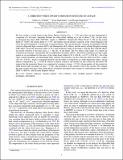A THIRD HOT WHITE DWARF COMPANION DETECTED BY KEPLER
Author(s)
Carter, Joshua Adam; Rappaport, Saul A.; Fabrycky, Daniel C.
DownloadCarter-2011-A THIRD HOT WHITE DW.pdf (4.115Mb)
PUBLISHER_POLICY
Publisher Policy
Article is made available in accordance with the publisher's policy and may be subject to US copyright law. Please refer to the publisher's site for terms of use.
Terms of use
Metadata
Show full item recordAbstract
We have found a system listed in the Kepler Binary Catalog (P orb = 3.273 days) that we have determined is comprised of a low-mass, thermally bloated, hot white dwarf orbiting an A star of about 2.3 M ☉. In this work, we designate the object, KIC 10657664, simply as "KHWD3" (Kepler Hot White Dwarf 3). We use the transit depth of ~0.66%, the eclipse depth of ~1.9%, and regular smooth periodic variations at the orbital frequency and twice the orbital frequency to analyze the system parameters. The smooth periodic variations are identified with the classical ellipsoidal light variation (ELV) and illumination (ILL) effects, and the newly utilized Doppler boosting (DB) effect. Given the measured values of R/a and inclination angle of the binary, both the ELV and DB effects are mostly sensitive to the mass ratio, q = M [subscript 2]/M [subscript 1], of the binary. The two effects yield values of q which are somewhat inconsistent—presumably due to unidentified systematic effects—but which nonetheless provide a quite useful set of possibilities for the mass of the white dwarf (either 0.26 ± 0.04 M ☉ or 0.37 ± 0.08 M ☉). All of the other system parameters are determined fairly robustly. In particular, we show that the white dwarf has a radius of 0.15 ± 0.01 R ☉, which is extremely bloated over the radius it would have as a fully degenerate object, and an effective temperature T effsime14,500 K. Binary evolution scenarios and models for this system are discussed. We suggest that the progenitor binary was comprised of a primary of mass ~2.2 M ☉ (the progenitor of the current hot white dwarf) and a secondary of mass ~1.4 M ☉ (the progenitor of the current A star in the system). We compare this new system with three other white dwarfs in binaries that likely were formed via stable Roche-lobe overflow (KOI-74, KOI-81, and the inner Regulus binary).
Date issued
2011-02Department
Massachusetts Institute of Technology. Department of Physics; MIT Kavli Institute for Astrophysics and Space ResearchJournal
Astrophysical Journal
Publisher
Institute of Physics/American Astronomical Society
Citation
Carter, Joshua A., Saul Rappaport, and Daniel Fabrycky. “ A THIRD HOT WHITE DWARF COMPANION DETECTED BY KEPLER .” The Astrophysical Journal 728, no. 2 (January 31, 2011): 139. © 2011 American Astronomical Society.
Version: Final published version
ISSN
0004-637X
1538-4357